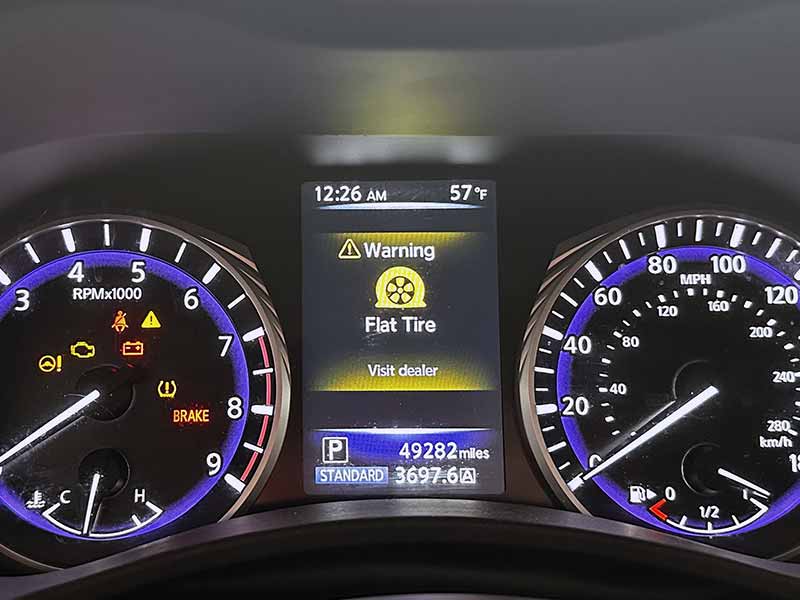You’re driving along when suddenly, your dashboard lights up with a low tire pressure warning. Pulling over, you check and find, to your astonishment, that the air pressure is zero. But then you remember: you have run flat tires. The question now racing through your mind is, can you safely make it to your destination without changing the tire?
How Long Can You Drive On A Run Flat Tire?
Run flat tires are designed to function even after losing all their air pressure, allowing drivers to continue for a limited distance, typically between 50 to 100 miles, at a reduced speed of around 50 mph.
In this article, we’ll delve deep into the mechanics of run flat tires, explore their benefits, debunk common myths, and provide guidance on their maintenance and care.
Let’s take a closer look.
What Makes Run Flat Tires Special?
Run flat technology is designed to allow a tire to continue functioning even after it has lost all its air pressure. This is achieved through:
- Reinforced Sidewalls: Unlike regular tires, run flats have thicker and sturdier sidewalls. These reinforced sidewalls provide the necessary support to the tire, allowing it to bear the weight of the vehicle even when it’s deflated.
- Self-Supporting System: The design of run flat tires incorporates a self-supporting system. This means that even with zero air pressure, the tire’s structure remains intact, preventing it from collapsing or coming off the rim.
Key Features of Run Flat Tires
- Safety: One of the primary benefits of run flat tires is enhanced safety. In the event of a sudden puncture, these tires reduce the risk of losing control of the vehicle, as they can maintain their shape and function for a limited distance.
- Convenience: With run flat tires, there’s no immediate need to pull over and change the tire. This can be particularly beneficial in unsafe areas or during adverse weather conditions.
- No Need for a Spare: Since run flats can be driven on for a certain distance after a puncture, many vehicles equipped with them don’t come with spare tires, saving space and weight.
Performance Under Pressure
While run flat tires are designed to function without air, it’s essential to understand their limitations:
- Limited Distance: After a puncture, run flat tires can typically be driven on for about 50 to 100 miles, depending on the tire’s make and model.
- Reduced Speed: When driving on a deflated run flat tire, it’s recommended to reduce speed to around 50 mph or the manufacturer’s suggested limit.

Driving with Zero Pressure: How Long and How Fast?
Run flat tires are designed to provide a safety net for drivers in the event of a puncture. But how do they perform when they’re completely deflated, and what are the recommended guidelines for driving on them? Let’s explore these questions in detail.
Can You Drive a Run Flat with Zero Pressure?
The simple answer is yes, but with some important caveats:
- Temporary Solution: Run flat tires are not meant to replace the need for tire repair or replacement. They offer a temporary solution, allowing drivers to reach a safe location or a nearby service station.
- Avoid Further Damage: Driving on a deflated run flat tire for extended periods or at high speeds can cause further damage to the tire, making it unrepairable.
Safe Speed Limit on a Deflated Run Flat
When driving on a run flat tire that has lost its air pressure:
- Recommended Speed: It’s advised to reduce your speed to around 50 mph or as suggested by the tire manufacturer. This ensures the tire doesn’t overheat or sustain further damage.
- Stay Alert: Drivers should be extra cautious, as the vehicle’s handling might be slightly different due to the deflated tire.
Duration: How Long Can You Drive?
The duration for which you can drive on a deflated run flat tire varies based on several factors:
- Tire Make and Model: Different run flat tires have different specifications. On average, they can be driven for about 50 to 100 miles after a puncture.
- Driving Conditions: Factors such as road surface, temperature, and vehicle load can influence how long a deflated run flat tire lasts.
After the Puncture: Next Steps
Once you’ve reached a safe location or service station:
- Inspection: Always have the tire inspected by a professional. They can determine if it’s repairable or if it needs replacement.
- Avoid Refilling with Air: Simply refilling a punctured run flat tire with air is not recommended. The tire might have sustained internal damage that isn’t visible from the outside.

Maintaining and Caring for Your Run Flat Tires
Run flat tires, with their unique design and capabilities, require special attention and care to ensure they perform optimally and last long. Here’s a guide on how to maintain and care for your run flat tires.
Understanding Tire Pressure
Air pressure is crucial for the performance and safety of any tire, including run flats:
- Tire Pressure Monitoring System (TPMS): Most vehicles equipped with run flat tires also come with a TPMS. This system alerts the driver when air pressure in a tire drops below a safe level. It’s essential to address these alerts promptly.
- Regular Checks: Even with a TPMS, it’s a good practice to manually check your tire pressure at least once a month using a reliable tire pressure gauge.
Can You Put Air in Run Flat Tires?
Yes, you can and should maintain proper air pressure in run flat tires:
- Refilling: If the tire pressure is low but there’s no puncture, you can refill the tire to the recommended pressure.
- Post-Puncture: If a run flat tire has been driven on with zero pressure, simply refilling it isn’t advisable. The tire should be inspected for potential damage before deciding on repair or replacement.
Life After a Puncture
After experiencing a puncture:
- Inspection is Key: Always get the tire inspected by professionals. They can assess the extent of damage and advise on the best course of action.
- Limitations: Remember that a run flat tire, once punctured and driven on, might not always be repairable. The internal structure could be compromised, necessitating a replacement.
General Care Tips
To maximize the lifespan and performance of your run flat tires:
- Rotate Regularly: Like all tires, run flats benefit from regular rotation, ensuring even wear across all tires.
- Avoid Overloading: Always adhere to your vehicle’s recommended load capacity. Overloading can strain and damage the tires.
- Drive Carefully: Avoid hitting curbs or driving through potholes. Such impacts can damage the tire’s sidewall, especially since run flats have reinforced sidewalls.

Benefits of Using Run Flat Tires
Run flat tires, often simply termed “run flats,” have been gaining traction among vehicle owners due to the unique advantages they offer. Let’s explore the key benefits of these innovative tires.
Safety First
One of the primary reasons drivers opt for run flat tires is the enhanced safety they provide:
- Reduced Risk of Accidents: In the event of a sudden puncture, traditional tires can cause a vehicle to swerve or lose control. Run flats, with their reinforced design, reduce this risk, allowing for a more controlled and safer driving experience.
- No Immediate Pull Over: With conventional tires, a puncture often means pulling over immediately, which can be risky on highways or in unsafe areas. Run flats give drivers the flexibility to continue driving to a safer location.
Convenience on the Road
Run flat tires are designed with the driver’s convenience in mind:
- Drive to Service: Instead of changing a tire on the side of the road, you can drive on a punctured run flat tire for a limited distance, allowing you to reach a service station or garage.
- No Spare Needed: Many vehicles equipped with run flats don’t come with a spare tire. This saves space in the trunk and reduces the vehicle’s weight, potentially improving fuel efficiency.
Peace of Mind
Knowing you’re equipped with run flat tires can offer peace of mind:
- Less Stress During Punctures: The sudden realization of a flat tire can be stressful. With run flats, drivers know they have a buffer to find a solution, reducing panic and hasty decisions.
- Cost-Efficient in the Long Run: While run flats might have a higher upfront cost, they can save money in the long run by potentially eliminating the need for a spare tire, jack, and other tire-changing tools.
Performance and Comfort
Run flat tires aren’t just about safety and convenience; they also offer a comfortable driving experience:
- Stiffer Sidewalls: The reinforced sidewalls of run flats not only provide support during punctures but also offer a smoother ride, reducing the effects of minor road imperfections.
- Optimized for Modern Vehicles: Many modern vehicles are designed with run flat tires in mind, ensuring optimal performance and handling.

Common Myths and Misconceptions
Like many innovative products, run flat tires are surrounded by a number of myths and misconceptions. As experts on tires for passenger cars and trucks, it’s essential to debunk these myths and provide clarity for drivers considering or currently using run flat tires.
Myth: Run Flats Can’t Be Repaired
Truth: While it’s true that some punctured run flat tires might not be repairable after being driven on with zero pressure, it doesn’t mean they can’t ever be repaired. The repairability depends on:
- The extent of the damage.
- The duration and speed the tire was driven on after the puncture.
- The tire’s overall condition.
Always consult with a tire professional to determine if a run flat tire can be repaired.
Myth: Run Flats Provide the Same Performance as Regular Tires
Truth: While run flat tires offer many benefits, their performance characteristics can differ from traditional tires. The reinforced sidewalls, which provide support during a loss of pressure, can result in a slightly firmer ride compared to conventional tires.
Myth: Vehicles with Run Flats Don’t Need a Tire Pressure Monitoring System (TPMS)
Truth: A TPMS is crucial for vehicles with run flat tires. Because run flats can maintain their shape even with significant air loss, it might be challenging for drivers to notice a puncture. A TPMS alerts drivers to changes in tire pressure, ensuring timely action.
Resources
Below are some links you may find helpful when learning about tires
Final Thoughts
Offering a blend of safety, convenience, and performance, run flat tires provide drivers with a buffer to reach a safe location or service station after a puncture.
However, like all innovations, it’s essential to understand their capabilities and limitations. Regular maintenance, timely inspections, and a clear understanding of their performance characteristics ensure that drivers can maximize the benefits of their run flat tires.
Good luck and happy motoring.





